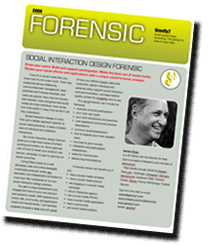). The research involved analysis of 150,000 tweets, treated as natural language expressions, or "talk". The aim of the research was to study tweets in which brands are mentioned for a number of attributes relevant to brands, including sentiment, purpose, frequency, and so on.
I found this interesting for several reasons. First was that I've been arguing of late that the conversational turn in social media (twitter, status updates, et al) makes everyday speech into a commodity. That the medium's translation of talk into a form that can be captured, saved, studied, mined, and so on only points to the further use of consumers for marketing purposes. (While I don't personally like this, it has a whiff of inevitability about it. The frontier having shifted from what we consume to what we say.)
This research is a rich study of the tweet in its commodity form: removed from the context of twitter user relationships and from any kind of transactional or conversational context. (Tweets used were extracted for their mention of a brand names studied.)
Secondly, the research finds that "most tweets that mention a brand do so as a secondary focus." I described this in much less precise terms last week, arguing that brands might focus less on how they are reflected in consumer sentiment and more on how the consumer seems to identify with and through brands in online social contexts. The research seems to have found, in other words, that brands are not the sole object of tweets that mention them. Brands are mentioned in passing, in conversation, yes, but not with the intent of soliciting interaction with the brand.
Interestingly, the research cites an assumption examined elsewhere that "consumers engaged in relationships with brands in a manner similar to the personal relationship they formed with people," adding that in online branding "These brand relationships may be the result of participation in brand communities."
I think there are nuances here worth some investigation. A brand's significance to a consumer may in fact have little in common with human relationships. Of course this changes if the brand community manager and consumer interact online. But the "brand" seems to me more likely to involve values, interests, and personal as well as social meanings associated with a brand but not directly caused by it.
Perceptions, reputation, trust, admiration, coveting... these are aspects of human relationships but are not in themselves relationships (to me, at least). And I think they are shaped socially, not in direct reflection on the brand's messaging and image-making.
Also of interest to brands in this study would be the preponderance of positive sentiments expressed in tweets that mention brands: "more than 80% of the tweets that mentioned one of these brands expressed no sentiment. This indicates that people are using Twitter for general information, asking questions, other information-seeking and -sharing activities about brands or products, in addition to expressing opinions about brands or products. Of the 268,662 tweets expressing sentiment, more than 52% of the individual tweets were expressions of positive sentiment, while ≈33% of tweets were negative expressions of opinion."
If I were a brand manager I would want to see these tweets in context. A research or monitoring tool able to show me context of conversation and something of the relationships that leap to life in the course of that conversation.
And I think it's important here to note that "relationships" can be fleeting, transient, and as they often are in conversational media, a sign of the medium's "coincidensity" and speed.
Referring to the brand model of Esch, Langner, Schmitt, & Geus, the authors write of online consumers, that "current purchases were affected by brand image directly and by brand awareness indirectly."
This will be obvious to a brand manager, but current twitter and social media analytics tools can derail the most disciplined analyst. Mentions are the most easily captured signs of social media relevance to branding. But "indirect awareness," which I read as "socially-mediated branding," is harder to track and quantify. Lest the ROI debate threaten to rear its head here, I still think that a softer, more subjective, "sociability" review belong to the social brand's marketing efforts.
Of the four types of brand-relevant tweeting listed here, for example, it would be interesting to know who sentiments were shared with; who was information solicited from; who was it provided to; and in what was the brand comment a reference to?
Furthermore, and I know that these questions aren't yet supported by tools, and so don't scale well: can the brand learn from how it is identified with, whether its social standing is increasing or slipping, or what kind of person the band information is sought from? Are users with social status, fame, success, knowledge, credibility as experts or reputations as critics, solicited or offered brand-relevant tweets?
I suspect that the types of expression listed here would need to be read closely for how they are addressed, and for how they might reflect on their authors. For tweets that mention brands are often a reflection of social relevance. A tweet asking for ticket information on a band is also a sign of an excited concert-goer: a sign of support and interest as much as the need for information.
- "Sentiment: the expression of opinion concerning a brand, including company, product, or service. The sentiment could be either positive or negative.
- Information Seeking: the expression of a desire to address some gap in data, information, or knowledge concerning some brand, including company, product, or service.
- Information Providing: providing data, information, or knowledge concerning some brand, including company, product, or service.
- Comment: the use of a brand, including company, product, or service, in a tweet where the brand was not the primary focus."
It's good to see research on this, and especially good to see research that regards tweets as utterances. If we are ascending the ladder of meaning and complexity from the word through the search phrase, on to the utterance, then perhaps it's not so far out to hope we will reach the rung of conversation in the not-so-distant future.
More from Twitter Power:Tweets as Electronic Word of Mouth:
They report that: "Of the 14,200 random tweets, 386 tweets (2.7%) contained mention of one of the brands or products from our list (Table 1). There were 2,700 tweets (19.0%) that mentioned some brand or product, inclusive of the brands that we used in this study."
And of greater interest to brands, would be the preponderance of positive sentiments expressed: "more than 80% of the tweets that mentioned one of these brands expressed no sentiment. This indicates that people are using Twitter for general information, asking questions, other information-seeking and -sharing activities about brands or products, in addition to expressing opinions about brands or products. Of the 268,662 tweets expressing sentiment, more than 52% of the individual tweets were expressions of positive sentiment, while ≈33% of tweets were negative expressions of opinion. This is in line with prior work such as that of Anderson (1998), who showed that there was a U-shape relationship between customer satisfaction and the inclination to engage in WOM transfers. This suggests that extremely positive and satisfied and extremely negative customers are more likely to provide information relative to consumers with more moderate experiences."
"As can be seen from Table 7, most tweets that mention a brand do so as a secondary focus. These tweets account for just under half of the branding tweets in this sample. Users expressed brand sentiment in 22% of the tweets. Interestingly, 29%of the tweets were providing or seeking information concerning some brand. This shows that there is considerable use of microblogging as an information source. This would indicate several avenues for companies, including monitoring microblogging sites for brand management (i.e., sentiment), to address customer questions directly (i.e., information seeking), and monitoring information dissemination concerning company products (i.e., information providing)."
Labels: sociability, social analytics, social marketing, twitter




Comments: :
blog comments powered by Disqus
<< Home